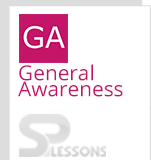 Introduction
Introduction
Banking Awareness is an important section in the employment-related competitive exams in India. In particular, exams like IBPS, SBI and other bank related employment exams have banking awareness questions along with general awareness section. The Banking Awareness section primarily has questions related to the History of Banking, Banking Terms, Banking Products, Functions of Banks, Banks and their Taglines, Schemes, Committees related to Banking, Headquarters of Banks, most recent Banking News, Apps launched by Banks, New Schemes, Monetary Policies etc.
IBPS SO Banking Awareness Quiz 3 article provides the list of several bank related questions to prepare aspirants of different competitive exams in India, primarily for banking related employment. The article IBPS SO Banking Awareness Quiz 3 is very useful for different exams such as IBPS SO, IBPS PO, Clerk, SSC CGL, SBI PO, NIACL Assistant, NICL AO, IBPS RRB, Railways, Civil Services etc.
 Quiz
Quiz
1. _____ is the rate at which the Reserve Bank is ready to buy or re-discount bills of exchange or other commercial papers.
- A. Bank Rate
B. CRR
C. Repo Rate
D. PLR
E. Reverse Repo Rate
- A. Personal Private Power
B. Primary Power Parity
C. Personal Private Parity
D. Purchasing Power Parity
E. Permanent Public Private
- A. Rs. 1 lakh
B. Rs. 2 lakh
C. Rs. 5 lakh
D. Rs. 50,000
E. No Limits
- A. State Bank of India
B. Government of India
C. Reserve Bank of India
D. Finance Ministry
E. None of the given options is true
- A. Cash
B. Company
C. Core
D. Currency
E. Common
1. MICR code is used for ________.
- A. For Code Banking Solution
B. For Electronic Funds Transfer
C. For Electronic Clearance of Cheques
D. For Cheque Truncation Services
E. None of the given options is true
- A. RBI
B. Individual banks
C. SBI
D. Finance Ministry
E. None of the given options is true
- A. 6 months
B. 3 months
C. 2 months
D. 1 month
E. 1 year
- A. Notice Money
B. Call Money
C. Term Money
D. Week Money
E. None of the given options is true
- A. Internet Banking
B. Credit Card
C. Mobile Apps
D. Demand Drafts of Banks
E. None of the given options is true
1. The Indian Financial System Code (IFS Code) is an alphanumeric code that uniquely identifies a bank-branch participating in the two main Electronic Funds Settlement Systems in India. IFSC code consists of how many alphanumeric codes?
- A. 10
B. 11
C. 9
D. 12
E. 8
- A. Dr. Nachiket Mor
B. Deepak Mohanty
C. AC Shan
D. BD Thakur
E. None of the given options is true
- A. Acquisition of small banks
B. Fixation of interest rates
C. Recovery of bad loans
D. Regulation of foreign exchange
E. None of the given options is true
- A. Net Demand and Term Liability
B. Net Demand and Time Liquidity
C. Net Demand and Trade Liquidity
D. Net Demand and Time Liability
E. None of the given options is true
- A. Bank
B. City
C. State
D. Branch
E. None of the given options is true



